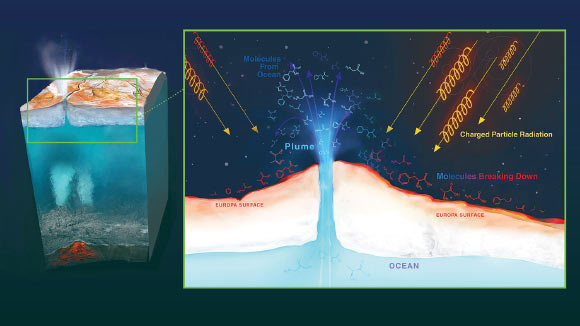Jupiter’s moon Europa is one of the most compelling targets in the search for life beyond Earth. However, its water-ice surface is affected by the harsh radiation environment of Jupiter’s magnetosphere. New mapping of the radiation pummeling the icy moon reveals where astrobiologists should look when searching for signs of biosignatures.
Now scientists know where to find regions least altered by radiation, which could be crucial information for NASA’s Europa Clipper mission.
The spacecraft may launch as early as 2022 and will carry cameras, spectrometers, plasma and radar instruments to investigate the composition of Europa’s surface, its ocean, and material that has been ejected from the surface.
“If we want to understand what’s going on at the surface of Europa and how that links to the ocean underneath, we need to understand the radiation,” said Dr. Tom Nordheim, a researcher at NASA’s Jet Propulsion Laboratory.
“When we examine materials that have come up from the subsurface, what are we looking at? Does this tell us what is in the ocean, or is this what happened to the materials after they have been radiated?”
Using data from Galileo spacecraft’s flybys of Europa two decades ago and electron measurements from Voyager 1, Dr. Nordheim and co-authors looked closely at the electrons blasting the moon’s surface.
They found that the radiation doses vary by location: the harshest radiation is concentrated in zones around the equator, and the radiation lessens closer to the poles.
Mapped out, the harsh radiation zones appear as oval-shaped regions, connected at the narrow ends, that cover more than half of the moon.
“This is the first prediction of radiation levels at each point on Europa’s surface and is important information for future Europa missions,” said co-author Dr. Chris Paranicas, a planetary scientist at the Johns Hopkins Applied Physics Laboratory.

Radiation processing map of Europa’s surface. Locations where magnetospheric radiation has processed surface material down to a depth of at least 4 inches (10 cm) are shaded blue. Image credit: Nordheim et al, doi: 10.1038/s41550-018-0499-8.
The researchers didn’t stop with a 2D map. They went deeper, gauging how far below the surface the radiation penetrates, and building 3D models of the most intense radiation on Europa.
The results tell us how deep scientists need to dig or drill to find any biosignatures that might be preserved.
The answer varies, from 4 to 8 inches (10-20 cm) in the highest-radiation zones down to less than 0.4 inches (1 cm) deep in regions of Europa at middle- and high-latitudes, toward the moon’s poles.
To reach that conclusion, the team tested the effect of radiation on amino acids, basic building blocks for proteins, to figure out how Europa’s radiation would affect potential biosignatures.
“The radiation that bombards Europa’s surface leaves a fingerprint,” said co-author Dr. Kevin Hand, a researcher at NASA’s Jet Propulsion Laboratory and project scientist for the potential Europa Lander mission.
“If we know what that fingerprint looks like, we can better understand the nature of any organics and possible biosignatures that might be detected with future missions, be they spacecraft that fly by or land on Europa.”
The findings appear in the journal Nature Astronomy.
Source: Sci News

































Leave a Comment
You must be logged in to post a comment.